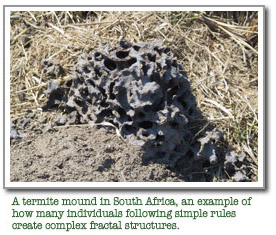Self-organization in biological systems
 Researchers throughout the basic sciences are interested in the self-organization of complex systems, the so-called study of complexity. In biology, the emergence of organized biological entities may lie at the heart of fundamental processes such as development, gene expression, and homeostatic regulation of large, complex organisms. Many biological systems “self-organize” into fractal-like branching networks of cells or individuals, suggesting that relatively few simple rules of biochemical signaling, behavior, or other interaction with the environment may underlie many common biological structures, such as cells, organs, organisms, or grouping behavior of individuals. This new field is in its infancy, but its potential for informing the development of biotechnology, nanotechnology, etc. is strong and there is tremendous excitement about any advances. I am currently searching for amenable experimental systems and analytical mathematical approaches to tackle some of the key questions in this field.
Researchers throughout the basic sciences are interested in the self-organization of complex systems, the so-called study of complexity. In biology, the emergence of organized biological entities may lie at the heart of fundamental processes such as development, gene expression, and homeostatic regulation of large, complex organisms. Many biological systems “self-organize” into fractal-like branching networks of cells or individuals, suggesting that relatively few simple rules of biochemical signaling, behavior, or other interaction with the environment may underlie many common biological structures, such as cells, organs, organisms, or grouping behavior of individuals. This new field is in its infancy, but its potential for informing the development of biotechnology, nanotechnology, etc. is strong and there is tremendous excitement about any advances. I am currently searching for amenable experimental systems and analytical mathematical approaches to tackle some of the key questions in this field.
Selected Related Publications:
Haskell, J.H., M.E. Ritchie, and H.Olff. 2002. Fractal geometry predicts varying body size scaling relationships for mammal and bird home ranges. Nature 418: 527-530. [PDF]
Olff, H. and M.E. Ritchie. 2002. Fragmented nature: consequences for biodiversity. Landscape and Urban Planning 58: 83-92.
Ritchie, M.E. and H. Olff. 1999. Spatial scaling laws yield a synthetic theory of biodiversity. Nature 400: 557-560. [PDF]
Ritchie, M.E. 1998. Scale-dependent foraging and patch choice in fractal environments. Evolutionary Ecology 12: 309-330.
